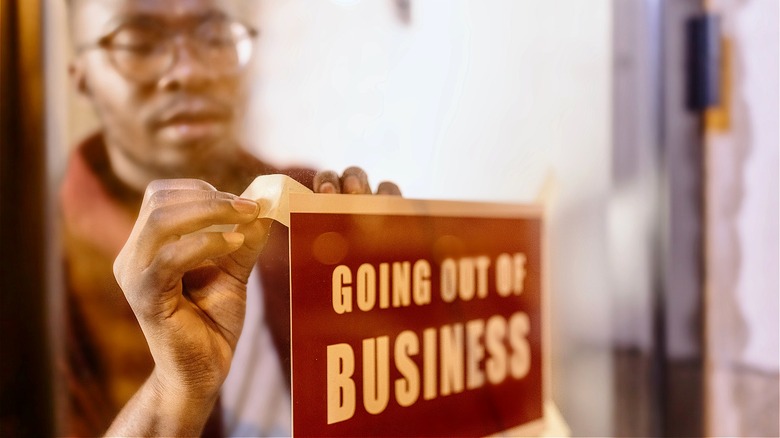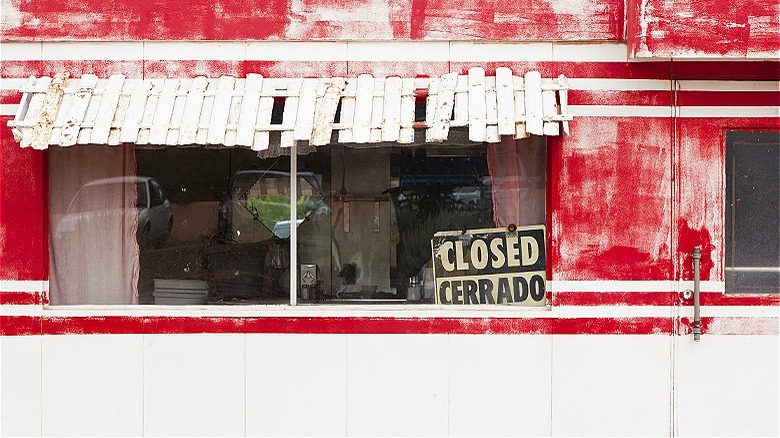Industries With The Highest Failure Rate For Small Businesses
Whether you've always dreamed of starting up your own small business or you're simply curious about the process, there's a lot to know about how they operate. Notably, there's also a lot to know about how often small businesses fail. From getting a startup loan to creating a business proposal, the process leading up to opening a business can often last longer than the business actually ends up being around. In fact, according to data from the Bureau of Labor Statistics, roughly 23.2% of all United States businesses failed in their first year of operation in 2022. According to a Lending Tree analysis, the numbers are even bleaker long-term with 48% of small businesses failing after five years, and 65.3% closing after 10 years.
While small businesses can and do fail for a host of different reasons, one of the biggest factors concerns cash flow for the business and funding. Most people who decide to open a small business grossly miscalculate just how much their expenses will be and/or just how little they will actually earn (according to Forbes, the average small business owner salary is just 16% above the national average of $59,428). This can quickly lead to financial shortfalls for a startup that can necessitate closing. Securing proper funding, making accurate budgets, and properly managing expenses are all key to ensuring small business success. Another significant factor in small business failure rates, though, is the competition surrounding certain popular industries (e.g., restaurants and retail) as opposed to faster-growing industries, which can lead to higher rates of failure.
Industries with highest failure rate
It goes without saying that the restaurant industry is plagued by business failures and premature closures. Not only is this due to the high proliferation of restaurant options today, but also the very thin profit margins that make it difficult for restaurants to survive their first year. According to Toast, the average profit margin for restaurants is usually between 3% to 5%, which leaves a small margin for error when it comes to pricing, ordering, and predicting the average price per customer.
Retail stores also face high failure rates. This is not only due to high competition from generally over-saturated markets but also in large part to online shopping and retail giants like Amazon, which are able to undercut prices beyond what a small business might be able to offer its customers. It's also worth mentioning that in 2021, Amazon accounted for more than half of all e-commerce sales in the entire country, which further hurts small brick-and-mortar businesses.
Another area with a high failure rate is the transportation and warehousing industry. With 24.8% of all businesses in this industry failing in their first year, it's easily one of the most difficult industries to succeed in. If you're wondering what, exactly, this industry entails, it's a combination of roles in air, rail, water, truck, and pipeline transportation. Its current high failure rate is largely thought to be due to the rise in inflation, which has put a damper on travel for many and therefore negatively impacted the transportation industry as a whole.
Worst places for small businesses
Despite the overall difficult outlook for small businesses in the U.S., some geographic locations are even harder than others. In particular, certain states have a higher small business failure rate. During the 2022 to 2023 year, Washington state had the highest business failure rate, with 40.8% of all new small businesses closing in their first year. The next highest closure rate was the District of Columbia with 32.2% of new businesses closing in the first year. The U.S. capital also has some of the worst outlooks for five- and 10-year failure rates in the country. Finishing out the top-three worst places for small businesses, Idaho had a one-year business failure rate of 30.7%.
There are a lot of factors that go into small business failures in the United States, and these three geographic regions in particular have unique circumstances that directly contribute to the failure rate of new businesses. For instance, Washington, D.C. has significantly higher rents than the rest of the country (it costs roughly $550 more to rent in this city compared to the rest of the U.S.), adding an additional financial burden on any new business that might attempt to open there. On the flip side, the lower median household income of Idaho residents could definitely be a contributing factor to small businesses that might have higher price points. Idaho also ranks sixth for its five-year small business failure rate. It's also worth noting the 2022 to 2023 year saw a significant rise in inflation that burdened businesses and consumers alike.


